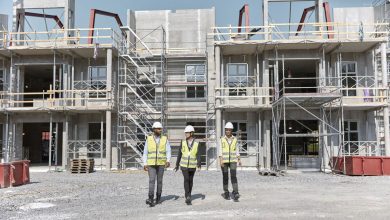Improving the energy performance of buildings
Buildings are responsible for 40% of energy consumption and 36% of CO2 emissions in the EU. While new buildings generally need fewer than three to five litres of heating oil per square meter per year, older buildings consume about 25 litres on average. Some buildings even require up to 60 litres.
Currently, about 35% of the EU’s buildings are over 50 years old. By improving the energy efficiency of buildings, we could reduce total EU energy consumption by 5-6% and lower CO2 emissions by about 5%.
On 19 December 2017, a provisional political agreement on new rules for improving the energy performance of buildings was reached between negotiators from the European Parliament, the Council and the Commission. The Commission’s proposal forms part of the implementation of the Juncker Commission priorities – in particular ‘a resilient Energy Union and a forward-looking climate change policy’. Pending its formal endorsement by the co-legislators, the agreement signals the closure of the first of 8 legislative proposals part of the Clean Energy for All Europeans package brought forward by the European Commission on 30 November 2016. It also shows that the work towards the completion of the Energy Union is on the way and that the work initiated by the Juncker Commission is being delivered.
The improvements agreed include measures to strengthen the energy performance of new buildings, to accelerate the rate of building renovation towards more energy efficient systems and tapping into the huge potential for efficiency gains in the building sector, the largest single energy consumer in Europe.
The fight against climate change starts ‘at home’, given that over a third of EU’s emissions is produced by buildings. By renovating and making them smart, we are catching several birds with one stone – the energy bills, people’s health, and the environment. And as technology has blurred the distinction between sectors, we are also establishing a link between buildings and e-mobility infrastructure and helping stabilize the electricity grid. Let’s stay on high gear,” Vice-President responsible for the Energy Union Maroš Šefčovič said.
“As the first agreement on a proposal of the Clean Energy for All Europeans Package, this is a step in the right direction. But I would have preferred to see a more ambitious commitment to e-vehicles charging points for non-residential buildings. This would have been more consistent with our commitments under the Paris Agreement and the European clean mobility strategy. But the new buildings directive will help create local jobs, save consumers money and improve our quality of life. I now call on the European Parliament and the Council to show ambition and complete the rest of the proposals of the Clean Energy for All Europeans Package,” Commissioner for Climate Action and Energy Miguel Arias Cañete added.
Main achievements
- Creates a clear path towards a low and zero emission building stock in the EU by 2050 underpinned by national roadmaps to decarbonise buildings.
- Encourages the use of information and communication technology (ICT) and smart technologies to ensure buildings operate efficiently for example by introducing automation and control systems.
- Supports the roll-out of the infrastructure for e-mobility in all buildings (although to a lesser extent than in the Commission’s proposal).
- Introduces a ‘smartness indicator’ which will measure the buildings’ capacity to use new technologies and electronic systems to optimise its operation and interact with the grid.
- Integrates long term building renovation strategies.
- Mobilises public and private financing and investment.
- Helps combatting energy poverty and reducing the household energy bill by renovating older buildings.
Next steps
Following this political agreement, the text of the Directive will have to be formally approved by the European Parliament and the Council. Once endorsed by both co-legislators in the coming months, the updated Energy Performance of Buildings Directive will be published in the Official Journal of the Union and will enter into force 20 days after publication. Member States will have to transpose the new elements of the Directive into national law after 18 months.
Background
The Energy Performance of Buildings Directive (EPBD) is part and parcel of the implementation of the Juncker Commission priorities to build ‘a resilient Energy Union and a forward-looking climate change policy’. The Commission wants the EU to lead the clean energy transition. For this reason, the EU has committed to cut CO2 emissions by at least 40% by 2030 while modernising the EU’s economy and delivering on jobs and growth for all European citizens. In doing so, the Commission is guided by three main goals: putting energy efficiency first, achieving global leadership in renewable energies and providing a fair deal for consumers.
The building sector in the EU is the largest single energy consumer in Europe, absorbing 40% of final energy, and about 75% of buildings are energy inefficient. Likewise, and depending on the Member State, only 0.4-1.2% of the stock is renovated each year. This opens a vast potential for energy efficiency gains in Europe as well as economic opportunities: the construction industry generates about 9% of European GDP and accounts for 18 million direct jobs. Construction activities that include renovation work and energy retrofits add almost twice as much value as the construction of new buildings, and SMEs contribute more than 70% of the value added in the EU building sector.
Significant upfront investment is required for the refurbishment of buildings. The EPBD is a substantial element of the European Commission’s work to make buildings more efficient and boost renovation. This work is accompanied by enabling tools for example the revised guidance for energy performance contracts (EPCs) which will help the building sector increase the necessary investments.
Furthermore, with the extended European Fund for Strategic Investments (EFSI 2.0) the Commission focus more on sustainable investments in all sectors to contribute to meeting the EU’s climate targets and to help to deliver on the transition to a resource efficient, circular and low-carbon economy. At least 40% of EFSI projects under the infrastructure and innovation window should contribute to the Commission’s commitments on climate action in line with the Paris Agreement objectives.
Under the existing Energy Performance of Buildings Directive:
- Energy performance certificates are to be included in all advertisements for the sale or rental of buildings;
- EU countries must establish inspection schemes for heating and air conditioning systems or put in place measures with equivalent effect;
- All new buildings must be nearly zero energy buildings by 31 December 2020 (public buildings by 31 December 2018);
- EU countries must set minimum energy performance requirements for new buildings, for the major renovation of buildings, and for the replacement or retrofit of building elements (heating and cooling systems, roofs, walls and so on);
- EU countries have to draw up lists of national financial measures to improve the energy efficiency of buildings
Under the Energy Efficiency Directive:
- EU countries make energy efficient renovations to at least 3% of buildings owned and occupied by central government;
- EU governments should only purchase buildings which are highly energy efficient;
- EU countries must draw-up long-term national building renovation strategies which can be included in their National Energy Efficiency Action Plans.







